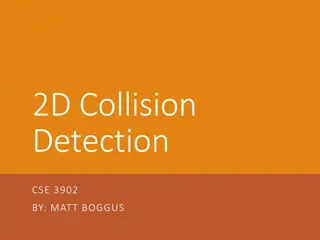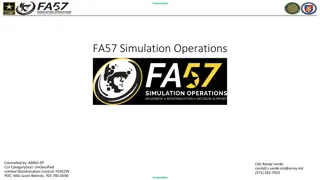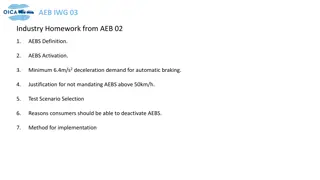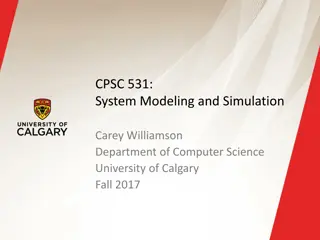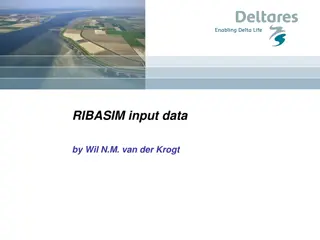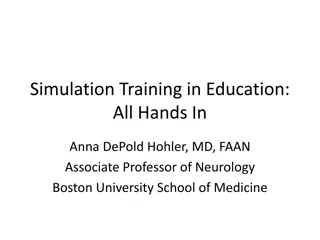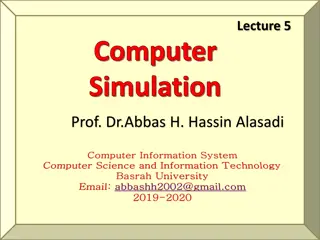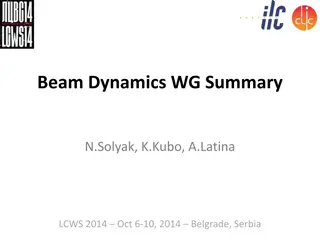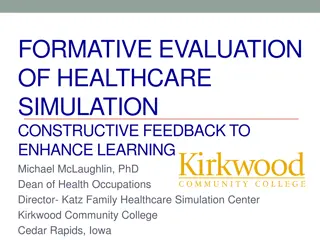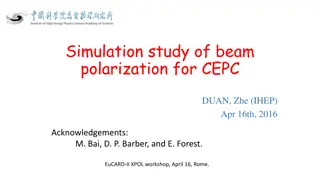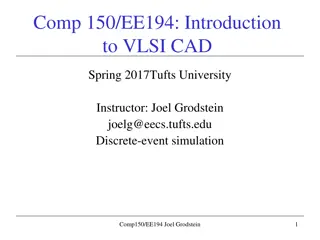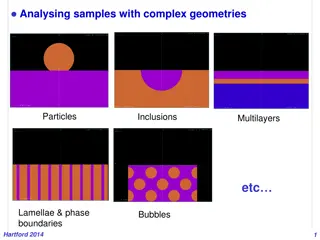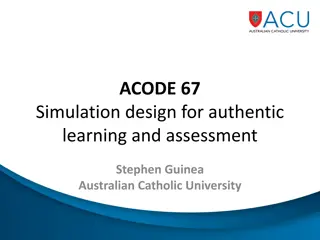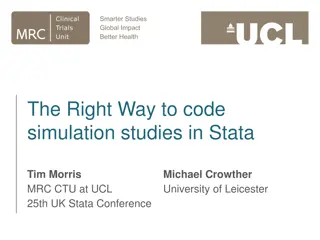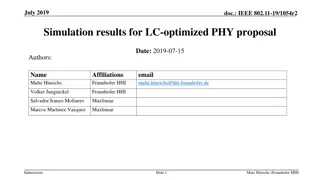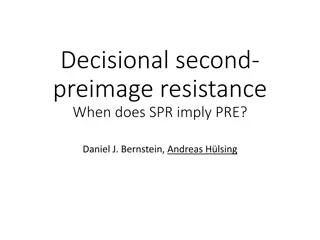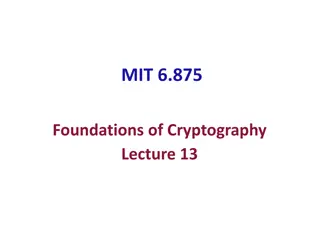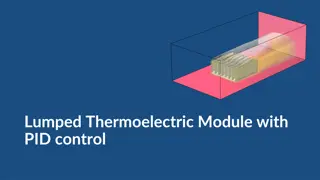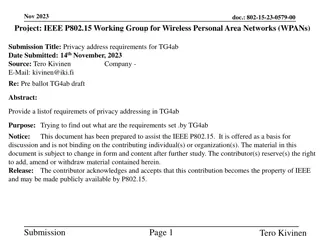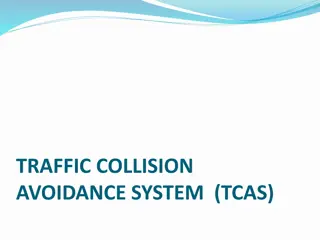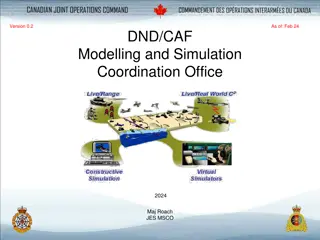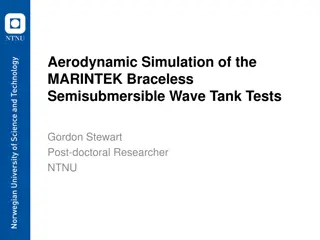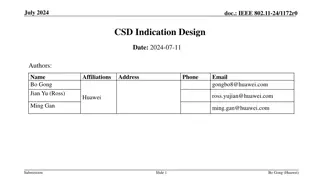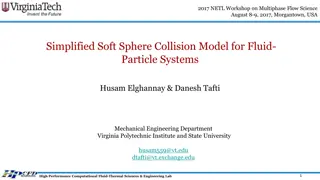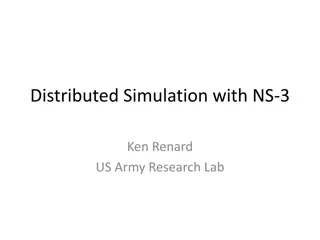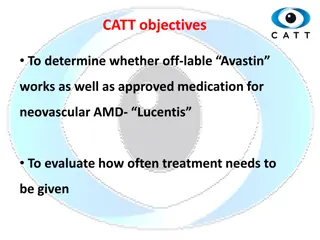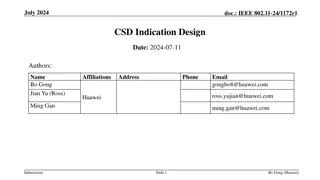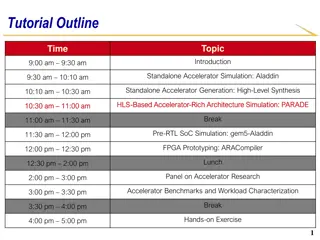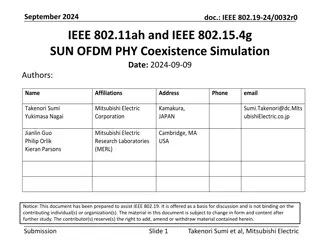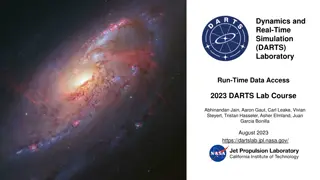System Modeling and Simulation Course Overview
This course covers the basics of systems modeling, discrete-event simulation, and computer systems performance evaluation. Topics include Monte Carlo simulation, probability models, simulation output analysis, queueing theory, and more. Professor Carey Williamson leads the course with a focus on pra
5 views • 21 slides
2D Collision Detection in Game Development
Explore the intricacies of 2D collision detection in game development through methods like distance checks, bounding shapes, and optimizing collision tests. Dive into concepts like sprite speed assumptions, square-square collisions, and rectangle testing complexities. Learn about useful Rectangle me
6 views • 29 slides
Overview of Army Modeling and Simulation Office
The U.S. Army Modeling and Simulation Office (AMSO) serves as the lead activity in developing strategy and policy for the Army Modeling and Simulation Enterprise. It focuses on effective governance, resource management, coordination across various community areas, and training the Army Analysis, Mod
2 views • 8 slides
How to Check a Simulation Study: Methods and Considerations
Simulation studies are often used to evaluate statistical methods and study power, but they can sometimes produce misleading results. This work discusses strategies to assess and improve the quality of simulation studies, drawing on experiences and considerations outlined in relevant literature. A s
0 views • 31 slides
Advanced Emergency Braking System (AEBS) Definition and Activation Guidelines
The provided content outlines the definition and activation requirements of the Advanced Emergency Braking System (AEBS). It covers the phases involved, including Collision Warning and Emergency Braking, as well as the speed limitations for activation. The system aims to automatically detect potenti
0 views • 12 slides
Monte Carlo Transport Simulation
Monte Carlo simulation is a stochastic technique that uses random numbers and probability statistics to investigate and solve problems. In the context of transport simulation, a Monte Carlo program simulates the passage of particles through matter, involving geometry, transport, visualization, detec
2 views • 11 slides
System Modeling and Simulation Overview
This content provides insights into CPSC 531: System Modeling and Simulation course, covering topics such as performance evaluation, simulation modeling, and terminology in system modeling. It emphasizes the importance of developing simulation programs, advantages of simulation, and key concepts lik
1 views • 28 slides
Basin Manipulation Simulation Analysis Tool Overview
Basin Manipulation Simulation Analysis Tool provides a comprehensive solution for managing and analyzing basin data, including tasks like basin manipulation, simulation analysis, case management, and defining simulation time steps. The tool allows for easy data entry, visualization of simulation res
6 views • 17 slides
Simulation Training in Education: Enhancing Learning Through Hands-On Simulation
Hands-on simulation training in education provides students with valuable learning experiences by increasing self-reported knowledge and technical proficiency. Simulations help improve students' knowledge, experience, and comfort with challenging procedures in a lower-risk environment, leading to en
0 views • 13 slides
Computer Simulation and Modeling Tools
Computer simulation and modeling is essential for conducting studies in various fields. Selecting the right simulation language or package is crucial for accurate results. This involves considering the characteristics of the language, such as random number generation, process transformers, list proc
2 views • 7 slides
Advanced Beam Dynamics and Machine Protection in High-Energy Linacs
Overview of recent talks and discussions at LCWS 2014 in Belgrade, Serbia, focusing on machine protection, simulation codes, instrumentation, and system tests. Topics include beam-loss monitors, dark current measurements, simulation code developments, and beam dynamics studies in linacs. Key speaker
1 views • 12 slides
Enhancing Healthcare Simulation Through Constructive Feedback
Explore the principles and benefits of healthcare simulation, focusing on formative evaluation and constructive feedback to improve learning outcomes. Delve into the role of formative assessment tools, TeamSTEPPS model, and Mayo High Performance Teamwork Scale in simulation scenarios. Discover the s
1 views • 37 slides
Beam Polarization Simulation Study for CEPC
Simulation study on beam polarization for the Circular Electron Positron Collider (CEPC) using the PTC Poly- morphic Tracking Code. The study includes orbital and spin tracking, equilibrium polarization calculation, and Monte-Carlo simulation of depolarization rate. Comparison with other Monte-Carlo
2 views • 20 slides
Introduction to VLSI CAD and Discrete-Event Simulation at Tufts University
This course introduces students to event-oriented simulation, building virtual models, and validating designs through simulation. It covers the importance of simulation in testing and refining designs before implementation. Examples include simulating VLSI networks and exploring the use of discrete-
0 views • 32 slides
Advanced Simulation Techniques for Analyzing Samples with Complex Geometries
Explore the capabilities of PENELOPE simulation software for analyzing samples with intricate structures like particles, inclusions, multilayers, lamellae, and phase boundaries. The software facilitates detailed investigations of material composition and electron-photon transport in diverse geometri
1 views • 28 slides
Simulation Design for Authentic Learning and Assessment at ACU
Simulation design for authentic learning and assessment is a crucial aspect of education, particularly in the healthcare field. At the Australian Catholic University (ACU), simulation plays a significant role in providing students with authentic experiences that bridge the gap between theory and pra
0 views • 18 slides
The Right Way to Code Simulation Studies in Stata
Simulation studies in Stata involve using (pseudo) random numbers to generate data from a distribution for studying statistical methods. This process helps to evaluate different scenarios and understand the properties of statistical techniques. Key components like ADEMP (Aims, Data-generating mechan
5 views • 18 slides
Simulation Results for LC-Optimized PHY Proposal in July 2019
The document presents simulation results for an LC-optimized PHY proposal for TGbb based on G.9991 PHY. It includes details on the simulation setup, frame detection results, header modulation, coding simulation results, payload modulation, and coding simulation results. The setup involved various re
1 views • 18 slides
The Relationship between Decisional Second-Preimage Resistance and Preimage Resistance in Cryptographic Hash Functions
This work delves into the subtle question of when Decisional Second-Preimage Resistance (SPR) implies Preimage Resistance (PRE) in hash functions. It presents a tool for enabling tight security proofs for hash-based signatures by exploring the success probability of adversaries against collision res
0 views • 25 slides
Foundations of Cryptography: Digital Signatures and Collision-Resistant Hash Functions
Foundations of Cryptography explores the construction of digital signature schemes and collision-resistant hash function families using one-way functions and safe primes. The content delves into the concept of collision-resistant hash functions and their construction from the discrete logarithm prob
0 views • 31 slides
Thermoelectric Module with PID Control Simulation
This simulation showcases a lumped thermoelectric module with PID control. The model evaluates the performance of a thermoelectric element in a nonisothermal fluid flow around a heat sink. A stationary simulation assesses the module's capabilities, followed by a transient simulation with a PID contr
1 views • 7 slides
Privacy Address Requirements for Wireless Personal Area Networks
This document discusses the privacy address requirements for IEEE P802.15 Working Group's TG4ab standard for Wireless Personal Area Networks (WPANs). It covers the need for 48-bit addresses with collision resistance, the use of different privacy addresses for each frame, and the adequacy of 12-bit c
0 views • 8 slides
TCAS - Traffic Collision Avoidance System
A Traffic Collision Avoidance System (TCAS) is a vital aircraft collision avoidance technology that helps reduce mid-air collisions by monitoring the airspace around an aircraft. TCAS operates independently of ground-based equipment and advises pilots on potential conflicting aircraft. Mandated by t
1 views • 13 slides
Defense Modeling and Simulation Coordination Office Overview
The Defense Modeling and Simulation Coordination Office (DND/CAF MSCO) is responsible for managing contractors, policies, and strategic activities related to modeling and simulation within the Canadian Armed Forces. The office focuses on supporting various organizations and enhancing capabilities th
2 views • 6 slides
Aerodynamic Simulation of MARINTEK Braceless Semisubmersible: Insights and Tools
Explore the aerodynamic simulation of the MARINTEK Braceless Semisubmersible through advanced techniques and tools. Discover the unique aerodynamic actuator, simulation models, and tools used in the research conducted by Gordon Stewart, a post-doctoral researcher at NTNU. Gain insights into the expe
0 views • 16 slides
Simulation Types for Ecosystem Modeling
Exploring different simulation types such as continuous and discrete event simulations for modeling complex systems like ecosystems. Detailed discussion on creating an ecosystem simulation with fish and bears on a grid, showcasing actions like breeding, moving, eating, and dying. Overview of a World
0 views • 31 slides
Proposal for IEEE 802.11-24/1172r0 CSD Indication Design
In this proposal authored by Bo Gong, Jian Yu (Ross), and Ming Gan from Huawei, the focus is on the allocation of CSDs by the AP in wireless communications. The document discusses the advantages of this approach, simulation results showing the impact of CSD collision, and the proposed method for CSD
6 views • 11 slides
Simplified Soft Sphere Collision Model for Fluid-Particle Systems
This workshop presentation discusses a simplified soft sphere collision model for fluid-particle systems, outlining the linear collision model, different existing implementations, validation of impacts, and proper conclusions. Formulations and experiments on oblique impacts are also explored, with r
0 views • 21 slides
Distributed Simulation with NS-3
Explore the world of distributed simulation with NS-3 as presented in "Distributed Simulation with NS-3" by Ken Renard from the US Army Research Lab. Get insights into the application of NS-3 in creating advanced simulations for military research and beyond. Dive into the details of distributed simu
0 views • 38 slides
OR Teamwork Faculty Development Program
Center for Medical Simulation's program focuses on improving teamwork in operating rooms to enhance patient safety. The initiative aims to train interprofessional teams using simulation as a medium, positively influencing the OR's working culture. Supported by an insurance incentive from Harvard CRI
0 views • 12 slides
Time-domain A-PPDU for Collision Reduction and Priority Access
This document introduces a Time-domain A-PPDU for IEEE 802.11-24, focusing on collision reduction and priority access for UHR STAs with low latency traffic. The proposal aims to enhance throughput, reduce MPDU loss, and minimize latency through innovative PPDU formatting. By implementing this approa
0 views • 12 slides
Real-Time Simulation Executive for DARTS Lab Course
The Dynamics and Real-Time Simulation (DARTS) Laboratory is developing an exemplar simulation executive for their 2023 course. The simulation aims to create a dynamic vehicle assembly, set up data logging, run simulations in real-time, and render related models. The project outlines requirements, go
0 views • 42 slides
Understanding Cryptographic Hash Functions and Applications
This collection of images and text introduces topics such as pseudorandom permutations, MACs, hash functions, and cryptographic hash function applications. It covers concepts like the pigeonhole principle, hash collisions, collision-resistant hash functions, and keyed hash functions. The content del
0 views • 20 slides
WLAN Frame Collision Information in IEEE 802.11-14/1106r1
Explore the severe problem of frame collisions in 11ax scenarios and how utilizing frame collision information can help reduce collisions, manage interference, and enhance network performance. Gain insights on the necessity of collision management in IEEE 802.11 WLAN environments. Examples of frame
0 views • 15 slides
IEEE 802.11 CSMA/CA Collision Analysis Insights
Delve into the collision analysis of CSMA/CA in IEEE 802.11 networks, exploring how collisions impact network latency and throughput. Gain valuable simulation data and observations on collision occurrences, deferral mechanisms, and adaptive contention techniques like AIFS and CW. Understand the basi
1 views • 16 slides
IEEE 802.11-24/1172r1 CSD Design Proposal for Improved Wireless Communication
Explore the advantages of allocating CSDs by AP in IEEE 802.11-24/1172r1 for enhanced AGC performance. This proposal suggests allocating CSDs per user by the AP, improving collision avoidance and optimized CSD allocation. Simulation results show reduced power gap ranges with and without collision, h
0 views • 12 slides
Accelerator-Rich Architecture: Research Tools and Simulation Techniques
Explore a comprehensive agenda covering various aspects of accelerator-rich architecture, from standalone simulation to FPGA prototyping. Key topics include Aladdin simulation, High-Level Synthesis (HLS) generation, PARADE architecture simulation, gem5-Aladdin SoC simulation, and more. Join the disc
0 views • 29 slides
IEEE 802.19-24 Simulation Update for Coexistence of IEEE 802.15.4g and IEEE 802.11ah
Explore the simulation update for the coexistence of IEEE 802.15.4g and IEEE 802.11ah in the September 2024 document. The study focuses on smart utility use cases, presenting simulation parameters, performance metrics, and the background of the study. Dive into the details of simulation models, depl
0 views • 14 slides
Understanding DARTS Lab: Simulation Objects, Data Access, and DVar Layer
Explore the Dynamics and Real-Time Simulation (DARTS) Laboratory's run-time data access, simulation objects, DVar documentation, and the importance of the DVar layer in providing standardized access to rich data for simulation objects. Discover the significance of this layer in decoupling services f
0 views • 21 slides
Understanding Collision Detection in Games
Explore the concept of collision detection in gaming, where objects interact on screen. Learn how to implement collision detection using rectangles in Python with the pygame library, ensuring that objects interact appropriately when they touch.
0 views • 27 slides

